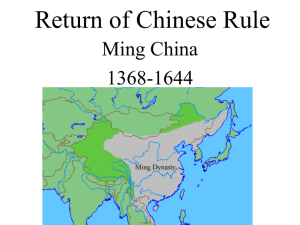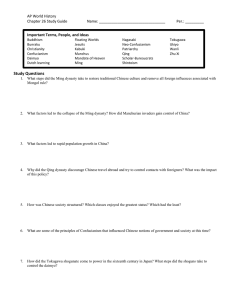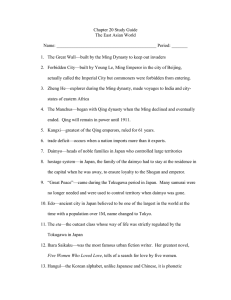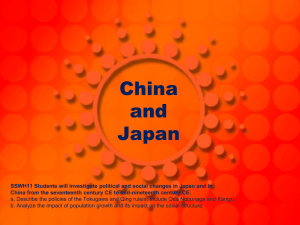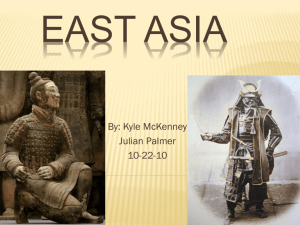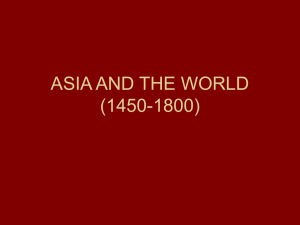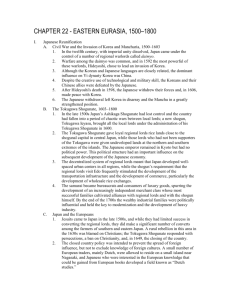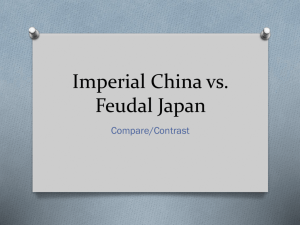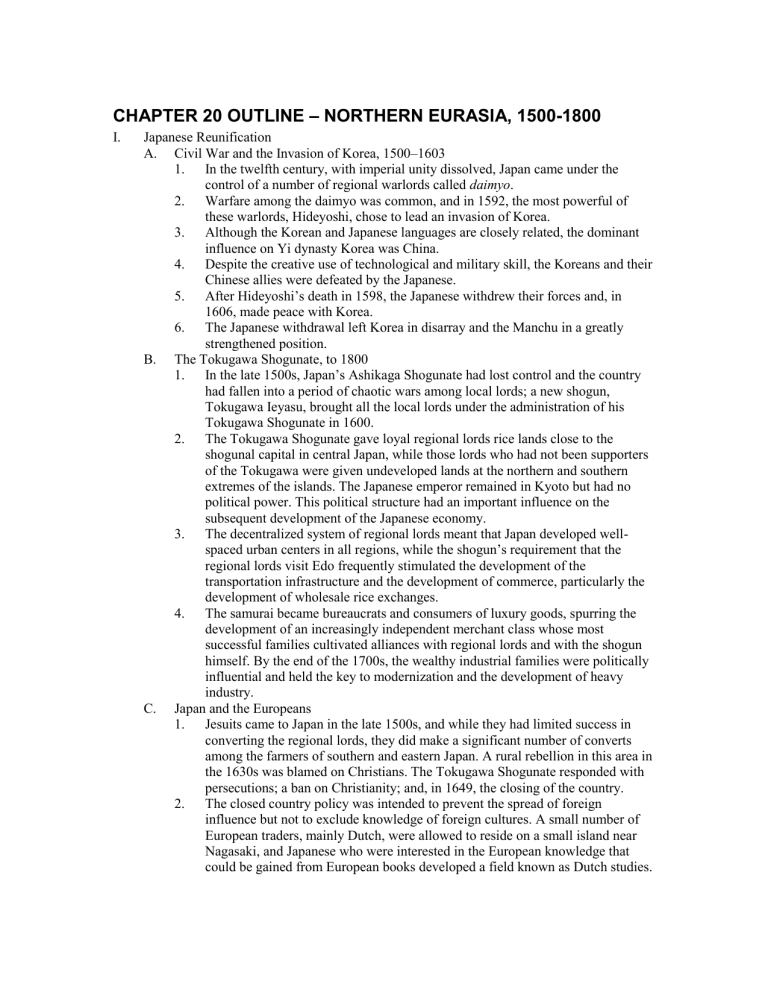
CHAPTER 20 OUTLINE – NORTHERN EURASIA, 1500-1800 I. Japanese Reunification A. Civil War and the Invasion of Korea, 1500–1603 1. In the twelfth century, with imperial unity dissolved, Japan came under the control of a number of regional warlords called daimyo. 2. Warfare among the daimyo was common, and in 1592, the most powerful of these warlords, Hideyoshi, chose to lead an invasion of Korea. 3. Although the Korean and Japanese languages are closely related, the dominant influence on Yi dynasty Korea was China. 4. Despite the creative use of technological and military skill, the Koreans and their Chinese allies were defeated by the Japanese. 5. After Hideyoshi’s death in 1598, the Japanese withdrew their forces and, in 1606, made peace with Korea. 6. The Japanese withdrawal left Korea in disarray and the Manchu in a greatly strengthened position. B. The Tokugawa Shogunate, to 1800 1. In the late 1500s, Japan’s Ashikaga Shogunate had lost control and the country had fallen into a period of chaotic wars among local lords; a new shogun, Tokugawa Ieyasu, brought all the local lords under the administration of his Tokugawa Shogunate in 1600. 2. The Tokugawa Shogunate gave loyal regional lords rice lands close to the shogunal capital in central Japan, while those lords who had not been supporters of the Tokugawa were given undeveloped lands at the northern and southern extremes of the islands. The Japanese emperor remained in Kyoto but had no political power. This political structure had an important influence on the subsequent development of the Japanese economy. 3. The decentralized system of regional lords meant that Japan developed wellspaced urban centers in all regions, while the shogun’s requirement that the regional lords visit Edo frequently stimulated the development of the transportation infrastructure and the development of commerce, particularly the development of wholesale rice exchanges. 4. The samurai became bureaucrats and consumers of luxury goods, spurring the development of an increasingly independent merchant class whose most successful families cultivated alliances with regional lords and with the shogun himself. By the end of the 1700s, the wealthy industrial families were politically influential and held the key to modernization and the development of heavy industry. C. Japan and the Europeans 1. Jesuits came to Japan in the late 1500s, and while they had limited success in converting the regional lords, they did make a significant number of converts among the farmers of southern and eastern Japan. A rural rebellion in this area in the 1630s was blamed on Christians. The Tokugawa Shogunate responded with persecutions; a ban on Christianity; and, in 1649, the closing of the country. 2. The closed country policy was intended to prevent the spread of foreign influence but not to exclude knowledge of foreign cultures. A small number of European traders, mainly Dutch, were allowed to reside on a small island near Nagasaki, and Japanese who were interested in the European knowledge that could be gained from European books developed a field known as Dutch studies. Some of the “outer lords” at the northern and southern extremes of Japan relied on overseas trade with Korea, Okinawa, Taiwan, China, and Southeast Asia for their fortunes. These lords ignored the closed country policy, and those in the south, in particular, became wealthy from their control of maritime trade. D. Elite Decline and Social Crisis 1. Patterns of population growth and economic growth also contributed to the reversal of fortunes between the inner and outer lords. Population growth in central Japan put a strain on the agricultural economy, but in the outer provinces, economic growth outstripped population growth. 2. The Tokugawa system was also undermined by changes in rice prices and in interest rates, which combined to make both the samurai and the regional lords dependent on the willingness of the merchants to give them credit. 3. The Tokugawa shoguns accepted the Confucian idea that agriculture should be the basis of the state and that merchants should occupy a low social position because they lacked moral virtue, but the decentralized political system made it difficult for the shogunate to regulate merchant activities. In fact, the decentralized system stimulated commerce so that, from 1600 to 1800, the economy grew faster than the population and merchants developed relative freedom, influence, and their own vibrant culture. 4. The ideological and social crisis of Tokugawa Japan’s transformation from a military to a civil society is illustrated in the Forty-seven Ronin incident of 1702. This incident demonstrates the necessity of making the difficult decision to force the military to obey the civil law in the interests of building a centralized, standardized system of law with which the state could protect the interests of the people. The Later Ming and Early Qing Empires A. The Ming Empire, 1500–1644 1. The cultural brilliance and economic achievements of the early Ming continued up to 1600. But at the same time, a number of factors had combined to exhaust the Ming economy, weaken its government, and cause technological stagnation. 2. Some of the problems of the late Ming may be attributed to a drop in annual temperatures between 1645 and 1700, which may have contributed to the agricultural distress, migration, disease, and uprisings of this period. Climate change may also have driven the Mongols and the Manchus to protect their productive lands from Ming control and to take more land along the Ming borders. 3. The flow of New World silver into China in the 1500s and early 1600s caused inflation in prices and taxes that hit the rural population particularly hard. 4. In addition to these global causes of Ming decline, there were also internal factors particular to China. These included disorder and inefficiency in the urban industrial sector (such as the Jingdezhen ceramics factories), no growth in agricultural productivity, and low population growth. B. Ming Collapse and the Rise of the Qing 1. The Ming also suffered from increased threats on their borders: to the north and west, there was the threat posed by a newly reunified Mongol confederation, and in Korea the Ming incurred heavy financial losses when it helped the Koreans to defeat a Japanese invasion. Rebellions of native peoples rocked the southwest, and Japanese pirates plagued the southeast coast. 2. Rebel forces led by Li Zicheng overthrew the Ming in 1644, and the Manchu Qing Empire then entered Beijing, restored order, and claimed China for its own. 3. II. 3. C. D. E. F. A Manchu imperial family ruled the Qing Empire, but the Manchus were only a small proportion of the population and thus depended on diverse people for assistance in ruling the empire. Chinese made up the overwhelming majority of the people and the officials of the Qing Empire. Trading Companies and Missionaries 1. Europeans were eager to trade with China, but enthusiasm for international trade developed slowly in China, particularly in the imperial court. 2. Over the course of the sixteenth century, the Portuguese, Spanish, and Dutch gained limited access to Chinese trade. 3. By the seventeenth century, the Dutch East India Company had become the major European trader in the Indian Ocean. 4. Catholic missionaries accompanied Portuguese and Spanish traders, and the Jesuits had notable success converting Chinese elites. The Jesuit Matteo Ricci (1552–1610) used his mastery of Chinese language and culture to gain access to the imperial court. Emperor Kangxi 1. Kangxi (r. 1662–1722) took formal control over his government in 1669 (at the age of sixteen) by executing his chief regent. Kangxi was an intellectual prodigy and a successful military commander who expanded his territory and gave it a high degree of stability. 2. During the Kangxi period, the Qing were willing to incorporate ideas and technology from Mongolian, Tibetan, Korean, and Chinese sources. The Qing also adapted European knowledge and technology—mapmaking, astronomy, and anatomical and pharmaceutical knowledge—taught by the Jesuits who frequented Kangxi’s court. 3. The Jesuits were also affected by their contact with China. They revised their religious teaching to allow Chinese converts to practice Confucian ancestor worship and they transmitted to Europe Chinese technology, including an early form of inoculation against smallpox and the management techniques of the huge imperial porcelain factories. Chinese Influences on Europe 1. The exchange of ideas and information between the Qing and the Jesuits flowed in both directions. 2. The wealth and power of the Qing led to a tremendous enthusiasm in Europe for Chinese things such as silk, tea, porcelain, other decorative items, and wallpaper. Jesuit descriptions of China also led Europeans such as Voltaire to see the Qing emperors as benevolent despots or philosopher-kings from whom the Europeans could learn. Tea and Diplomacy 1. The Qing were eager to expand trade, but they wanted to control it to be able to tax it more efficiently and to control piracy and smuggling. To do so, the Qing designated a single market point for each foreign sector: the market point for those coming from the South China Sea (including the various European traders) was the city of Canton. This system worked fairly well until the late 1700s. 2. In the late 1700s, the British East India Company and other English traders believed that China’s vast market held the potential for unlimited profit and thought that the Qing trade system (the Canton System) stood in the way of opening up new paths for commerce. At the same time, the British Parliament was worried about the flow of British silver into China and convinced that opening the China market would help to bring more English merchants into the trade and bring about the end of the outmoded and nearly bankrupt East India Company. 3. In 1793–1794, the British sent a diplomatic mission led by Lord Macartney to open diplomatic relations with China and revise the trade system. The Macartney mission was a failure, as were similar diplomatic embassies sent by the Dutch, the French, and the Russians. G. Population and Social Stress 1. The peace enforced by the Qing Empire and the temporary revival of agricultural productivity due to the introduction of American and African crops contributed to a population explosion that brought China’s total population to between 350 million and 400 million by the late 1700s. 2. Population growth was accompanied by increased environmental stress: deforestation, erosion, silting up of river channels and canals, and flooding. The result was localized misery, migration, increased crime, and local rebellions. 3. While the territory and the population of the Qing Empire grew, the number of officials remained about the same. The Qing depended on local elites to maintain local order but was unable to enforce tax regulations; control standards for entry into government service; or prevent the declining revenue, increased corruption, and increased banditry in the late 1700s. III. The Russian Empire A. The Drive Across Northern Asia 1. Following the dissolution of Mongol power in Russia, the city of Moscow became the foundation for a new state, Muscovy, which absorbed the territory of the former Kievan state and Novgorod in the west and conquered the khanates of Kazan and Astrakhan. The Muscovite ruler Ivan IV took the title of tsar in 1547. 2. The natural direction for Russian expansion was east; expansion in Siberia was led by armed adventurers who defeated the only political power in the region, the Khanate of Sibir, and took land from the small hunting and fishing groups of native people. Siberia was valued first for its furs and timber and as a penal colony. 3. In the 1650s, the expanding Russian Empire met the expanding Qing Empire in Mongolia, Central Asia, and along the Amur. A treaty between the two powers in 1689 recognized Russian claims west of Mongolia. B. Russian Society and Politics to 1725 1. As the empire expanded, it incorporated a diverse set of peoples, cultures, and religions. This often produced internal tensions. 2. The Cossacks belonged to close-knit bands and made temporary alliances with whoever could pay for their military services. 3. Despite the fact that the Cossacks often performed important services for the Russian Empire, they managed to maintain a high degree of autonomy. 4. Threats and invasions by Sweden and Poland and internal disputes among the Russian aristocracy (boyars) in the seventeenth century led to the overthrow of the old line of Muscovite rulers and the enthronement of Mikhail Romanov in 1613. The Romanov rulers combined consolidation of their authority with territorial expansion to the east. 5. As the power of the Romanov rose, the freedom of Russian peasants fell. 6. In 1649, Russian peasants were legally transformed into serfs. C. Peter the Great 1. Peter the Great (r. 1689–1725) fought the Ottomans in an attempt to gain a warm-water port on the Black Sea and to liberate Constantinople (Istanbul) from Muslim rule, but he did not achieve either goal. Peter was more successful in the Great Northern War, in which he broke Swedish control over the Baltic and established direct contacts between Russia and Europe. 2. Following his victory in the Great Northern War, Peter built a new capital, St. Petersburg, which was to contribute the westernization of the Russian elites and demonstrate to Europeans the sophistication of Russia. The new capital was also intended to help break the power of the boyars by reducing their traditional roles in the government and in the army. 3. Peter wanted to use European technology and culture to strengthen Russia and to strengthen the autocratic power of his government; he was not interested in political liberalization. As an autocratic ruler, Peter brought the Russian Orthodox Church under his control; built industrial plants to serve the military; and increased the burdens of taxes and labor on the serfs, whom the Russian Empire depended upon for the production of basic foodstuffs. D. Consolidation of the Empire 1. Russian expansion in Alaska and the American northwest was driven by the search for furs, which British and American entrepreneurs had also been interested in. Control of the natural resources of Siberia put the Russians in a position to dominate the fur and shipping industries of the North Pacific. 2. During the reign of Catherine the Great (r. 1762–1796), Russia was the world’s largest land empire, built on an economic basis of large territory, agriculture, logging, fishing, and furs. IV. Conclusion A. Political Comparisons 1. Between 1500 and 1800, China and Russia grew dramatically, both in territory controlled and population. 2. Despite being headed by an emperor, Japan’s size, homogeneity, and failure to add colonies disqualify it from being called a true empire. 3. Japan and Russia made greater progress in improving their military than did China. 4. Of Japan, Russia, and China, Russia did the most to build up its imperial navy. B. Cultural, Social, and Economic Comparisons 1. As they expanded, both China and Russia pursued policies that tolerated diversity while promoting cultural assimilation. 2. While both Russian and Chinese leaders were willing to use foreign ideas and technologies, they tended to see their own culture as superior. 3. Merchants occupied a precarious position in both China and Japan.
